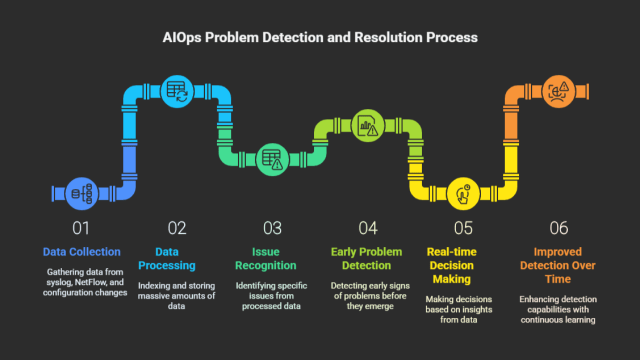From Ops to Autos: How AIOps and Agentic AI Are Redefining IT Operations
- David Bigger

- Jun 26
- 3 min read

What Are AIOps and Agentic AI?
Imagine running a massive airport. Thousands of flights, weather changes, maintenance needs, security events—it’s pure chaos if you manage it all manually.
AIOps, or Artificial Intelligence for IT Operations, is like having an advanced air traffic control system for your IT environment. It constantly monitors signals from every part of your infrastructure—servers, networks, applications—and uses machine learning, big data, and automation to detect when something looks off. It correlates events, cuts through the noise, and surfaces actionable insights fast, so teams can respond before small issues escalate [1].
But Agentic AI? That’s like adding autonomous aircraft that can self-diagnose, reroute, or land safely if something goes wrong—without waiting for human instructions. These AI-driven agents act independently within defined guardrails, learning from context, adapting over time, and resolving issues with minimal human involvement. Unlike static automation scripts that only execute predefined tasks, agentic AI evolves, making your IT operations smarter, faster, and more resilient [2].
Together, AIOps and Agentic AI shift IT from reactive firefighting to proactive, autonomous operations—keeping systems stable and secure even as complexity grows.
Real-World Applications and Benefits
Organizations are already seeing the impact of AIOps and Agentic AI:
NTT Data SPEKTRA Platform: Resolves up to 95% of incidents before they affect users. Organizations report five times fewer tickets per device and 30% faster ticket handling [3].
Cisco AI Canvas and AgenticOps: Integrates telemetry from Meraki, ThousandEyes, and Splunk, providing unified diagnostics with 20% higher accuracy. The system offers autonomous recommendations and actions, improving root cause identification and resolution [4].
LogicMonitor’s Edwin AI: Agentic AI that detects, correlates, and resolves incidents. In one example, a manufacturing client reduced mean time to resolution (MTTR) by 50%, slashed downtime by 45%, and saved approximately $175,000 per month [5].
Quantified Outcomes
Here’s what these technologies deliver in measurable terms:
Benefit | Impact |
|---|---|
MTTR Reduction | Up to 50% faster incident resolution [5] |
Ticket Volume Decrease | Five times fewer tickets in production environments [3] |
Downtime Elimination | Over $175,000 in monthly savings for manufacturers [5] |
Diagnostic Accuracy Boost | 20% improvement through AI-driven correlation [4] |
Security and Readiness Considerations
Adopting autonomous operations brings significant benefits, but it’s not risk-free. A recent survey shows 90% of organizations are unprepared for AI-powered threats, creating a dangerous gap between AI adoption and security readiness [6].
To safely implement AIOps and Agentic AI:
Apply zero-trust principles to all AI agents and machine identities.
Sandbox agent actions to limit potential damage from errors or attacks.
Enforce comprehensive logging and auditing for all autonomous activities.
Implement feedback loops for human oversight and continuous learning.
Strengthen data governance across all telemetry sources feeding AI engines.

Getting Started with AIOps and Agentic AI
A thoughtful rollout of these technologies requires a structured approach:
Start with monitoring and correlation: Implement AIOps to centralize data, detect anomalies, and generate actionable alerts.
Pilot autonomous responses: Begin with low-risk scenarios like restarting services or adjusting resources.
Choose reliable partners: Solutions from Cisco, NTT Data, LogicMonitor, and other vendors provide proven platforms.
Prioritize security: Incorporate identity management, sandboxing, and policy controls from day one.
Track improvements: Measure MTTR, ticket volume, downtime, and diagnostic accuracy to demonstrate ROI and refine operations.
The Road Ahead

The future of IT operations is autonomous, observant, and intelligent. Research frameworks like AIOPSLAB and TelOps show self-healing, closed-loop environments moving from theory to production [7][8].
Whether you’re overseeing cloud platforms, edge infrastructure, or complex networks, adopting AIOps and Agentic AI means faster issue resolution, greater uptime, and more resilient operations.
Teams that embrace this shift now will be the ones leading tomorrow’s IT landscape.
Sources
LogicMonitor. “What is AIOps?” Retrieved from https://www.logicmonitor.com/blog/what-is-agentic-aiops-and-why-is-it-crucial-for-modern-it
Wikipedia. “Agentic AI.” Retrieved from https://en.wikipedia.org/wiki/Agentic_AI
NTT Data. “AIOps Injects Intelligence into the Heart of IT Operations.” Retrieved from https://services.global.ntt/en-us/insights/blog/aiops-injects-intelligence-into-the-heart-of-it-operations
Cisco Blogs. “Network Operations for the AI Age.” Retrieved from https://blogs.cisco.com/innovation/network-operations-for-the-ai-age
LogicMonitor. “Agentic AIOps Use Cases.” Retrieved from https://www.logicmonitor.com/blog/agentic-aiops-use-cases
Axios. “Most Companies Aren’t Ready for AI-Powered Threats.” Retrieved from https://www.axios.com/2025/06/26/accenture-executives-cybersecurity-ai-plans
arXiv.org. “AIOPSLAB: Evaluating AIOps in Cloud Environments.” Retrieved from https://arxiv.org/abs/2501.06706
arXiv.org. “TelOps: AI Agents for Telecommunications Operations.” Retrieved from https://arxiv.org/abs/2412.04731






Comments